#create form in ms access
Explore tagged Tumblr posts
Text
The End of an Era - Philip Morris Has Left Ferrari
I was considering writing about the Daytona 500 and the state of superspeedway racing, but quite frankly, I didn't want to go on a super negative rant saying a thousand things that have already been said about NASCAR plate tracks.
Fortunately for me, something else happened.
The Decalspotters twitter account noticed that Philip Morris International is no longer listed on the bottom of the page sponsors on the Ferrari website. Using the wayback machine, I was able to confirm that the Philip Morris International logo was still there in November 2024, so they were removed specifically for the 2025 season.
Now, Philip Morris hasn't been on the cars in awhile. Their last attempt, on and off from late 2018 until 2022, was with Mission Winnow, a brand seemingly created for the sole purpose of subliminal advertising.
By 2023 they seemed to have abandoned this plan and the logo on the website changed from Mission Winnow to Philip Morris International, which is how it was all the way up until the end of the 2024 season.
Nobody has run with the story quite yet, but it appears that Philip Morris has finally left Ferrari.
You can still access the Philip Morris page on Ferrari.com if you search for it specifically, but the same thing applies to Santander, and we know they're gone. Ferrari has even signed UniCredit as a replacement bank sponsor.
This is huge, as Philip Morris has been in F1 in some form since 1972 and has been with Ferrari in some form since 1973 when they became a driver sponsor. 1973 to 2024 is perhaps the longest sports sponsorship ever, and even if you don't want to count the driver deals, they've been a team sponsor of Ferrari since 1984, which is still a forty year run.
So is this the end of tobacco sponsorship in F1?
Not really.
McLaren has a partnership with British American Tobacco (the same company that owned BAR and also acquired Rothmans International in 1999, which had sponsored Williams with its Rothmans and Winfield brands). BAT dodges restrictions in a number of ways, with the A Better Tomorrow subliminal advertising brands, as well as Vuse vapes and Velo nicotine pouches.
Vapes, all the health risks of cigarettes with none of the coolness.
I say that flippantly, smoking isn't cool: it stinks, and it kills you.
Tobacco liveries did, however, have a great aesthetic to them. I wish the likes of Marlboro, Player's, KOOL, Benson & Hedges, and all the rest would make like teddy bears or koala heart transplants or something because they made a lot of pretty race cars and their money funded a great deal of racing teams.
Though the problem there is that the very reason why tobacco got so big in motorsports is because they weren't allowed to sponsor anywhere else. Marlboro poured millions into Ferrari, Penske, and Ducati because those were the only places where they could still show their logos.
The most iconic racing sponsors only became iconic because their products were so deadly they couldn't advertise anywhere else.
In fact, a small part of the reason why NASCAR got so big is probably because tobacco liveries weren't that big in NASCAR. The series had a title sponsorship with Winston, and because of the Viceroy Rule - something I've discussed previously on this blog and itself a product of tobacco sponsorship - none of the other cigarette companies could touch NASCAR teams.
So instead of the best drivers being sponsored by Marlboro or Camel or West, they were sponsored by DuPont, Kellogg's, and Home Depot.
Brands that you could market to anyone, even kids.
Thus, the kids of the 90s and 2000s grew up with NASCAR diecasts and wearing M&Ms jackets instead of repping tobacco-laden F1 or CART merch.
There's a lot more to NASCAR's rise than that, but it likely has something to do with why, when the average American thinks about racing, all they know is NASCAR.
And when the entire field decides to wreck repeatedly so that the guy who starts the final lap in ninth manages to stumble into the win, that ubiquitousness of NASCAR makes all of racing look bad.
Positive though, stay positive...
How about a quick rundown on Marlboro in F1?
Well, the story begins in 1972, with Marlboro signing on to sponsor the BRM team. BRM was British, as the name British Racing Motors may suggest, but like their name also suggests, they made their own engines. BRM weren't a garagista team running the Cosworth DFV (Cozzeh!), instead, they were running their own 3.0L V12.
It was in one of these 3.0L V12 BRMs that Peter Gethin drove the car out of a giant Marlboro pack to unveil the car. The Marlboro era had begun.
They won their first race that year with Frenchman Jean-Pierre Beltoise winning in Monaco.
That was their only major success that year, as that win, paired with a 4th in Germany, and then 6th in both Austria and Germany was only good enough for 7th in the standings.
1973 was even worse, as despite running a stacked lineup of Beltoise, Clay Regazzoni, and Niki Lauda, they were still in seventh. In fact, their points total slipped from 14 to 12, and they didn't even have the saving grace of a win or a podium.
Thus, Marlboro went to McLaren for 1974, while Lauda and Regazzoni went to Ferrari, where they'd wear Marlboro patches as well.
The Marlboro McLaren partnership was obviously successful, with Emerson Fittipaldi winning the title in 1974, James Hunt in 1976, Niki Lauda in 1984, Alain Prost in 1985, 1986, and 1989, and Ayrton Senna in 1988, 1990, and 1991.
The success continued when Marlboro went to Ferrari, where Marlboro progressed from mere sponsor in 1984 to main sponsor by 1993, and finally becoming title sponsor from 1997, after the McLaren deal had ended.
Ferrari won the constructors' championship in 1999, followed by Michael Schumacher winning the drivers' championship in 2000, 2001, 2002, 2003, and 2004. Kimi Raikkonen would add a title to the list in 2007, Ferrari's last championship to date.
The team was still officially Scuderia Ferrari Marlboro all the way up until the 2011 British Grand Prix. After that, Philip Morris' sponsorship became more subtle, first with the new-for-2011 Scuderia Ferrari logo that many accused of mimicking the Marlboro logo - and it didn't help that it took the engine cover placement that Marlboro's bar code filled until the 2010 Spanish Grand Prix - along with a similar rebrand from Ducati Corse in MotoGP.
That part is all pretty well-known, but what some people may not know if how widespread Marlboro sponsorship really was.
Back in 1973 and 1974, while Marlboro was sponsorship the BRM and McLaren teams, they also supported the original Frank Williams Racing Cars team, with the cars initially known as Iso-Marlboros.
Not too long after, Marlboro would sponsor the Alfa Romeo team from 1980 to 1983, during their McLaren years.
Then from 1988 to 1992, Marlboro would sponsor the BMS Scuderia Italia team, an Italian backmarker that is best known for becoming a Ferrari B-team in 1992 and 1993, the first of those years being with Marlboro, the latter year with Chesterfield as sponsor.
Merzario, Team Rebaque, Fittipaldi, Spirit, Rial, EuroBrun, Onyx, Arrows, Minardi, and Forti would all also carry minor Marlboro sponsorship at one point or another.
That's just the team deals, if I tried to list out all the drivers that Marlboro sponsored...we'd be here all day. Plenty of drivers would have Marlboro on their helmet or overalls with driving for a team with different sponsors.
One such case was Michele Alboreto, who was at Tyrrell in 1989 and had Marlboro paying his salary at the unsponsored team...until Ken Tyrrell secured Camel as a sponsor. Alboreto refused to break off his deal with Marlboro, so Tyrrell had to fire him and replace him with a young up-and-comer named Jean Alesi.
Michele Alboreto then lost his Marlboro sponsorship because he didn't have a ride anymore.
Two races later, Micheel Alboreto found a ride at Larrousse...which was also sponsored by Camel. Meaning Alboreto was wearing Camel stickers on his helmet and overalls anyway.
A very pointless episode, but one that kicked off the career of Jean Alesi.
Jean Alesi who would then race for the Marlboro-sponsored Ferrari from 1991 and 1995.
Tobacco money made everything go full circle.
30 notes
·
View notes
Text
a further look at the rest of my fanseasons
as i was pulling up images for justice, paradise, and lune last night i came across a bunch of images for my other fanseasons. figured i might as well share them so people can see what they look like as well (at at the very least the prototype ones since i don't have accessible traditional art for most of them curse you past justie for not taking photos!)
shining hearts:
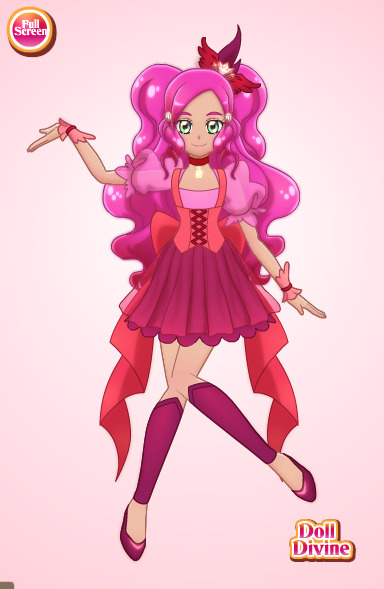
here's the first image of cure harmony, dated december 16 2018. done in the glitter cure maker
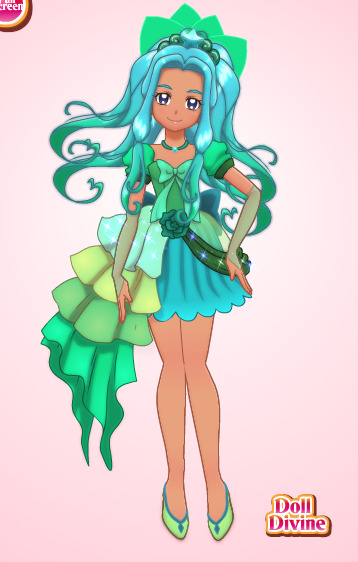
from that same day, the prototype for cure sunburst, cure elemental. i didn't feel like making up an entirely new character at the time though and i was already using an older oc for cure harmony so i was like "i'll just take another one of my mlp ocs" (which was sunburst) so elemental ended up being shoved to the side

from june 2019, the team in the happiness charge character creator by hapuriainen (i hope i spelled that right) on deviantart! this was another one of my favorite character creators, and provided the basis for many a cure design before glitter cure came out on dolldivine
we now have cure harmony (pink), cure sunburst (orange), and their midseason, cure spark (green)
time to fast forward, since we have now hit the era of the Precure Art Drought. the next time i drew any of them was cure harmony in january 2022, as one of the ms paint base pieces i did:

base is cure happy by selenaede.
and then we have her again in january 2023, as part of the star twinkle trace that showed up in the paradise & lune post
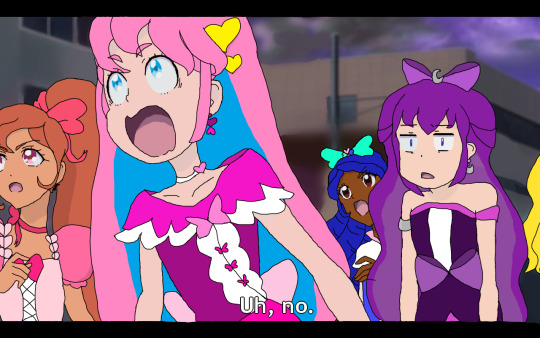
harmony is in the foreground. her bangs are fluffier now but this is largely the design i've stuck with for her ever since. the blue in her hair is a reference to her days as a my little pony oc - she started out as a pink unicorn with fluffy pink hair and then i got into an argument with one of my online friends over if she looked too much like pinkie pie or not so i added the blue streak to differentiate her
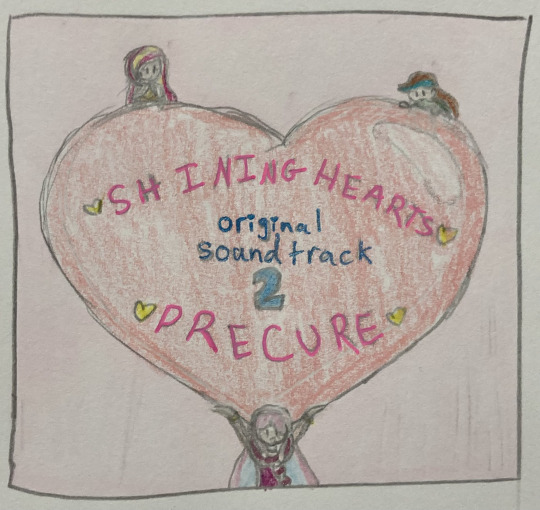
and from january 2024, here's all on them on their second ost cover!
mermaid jewel:
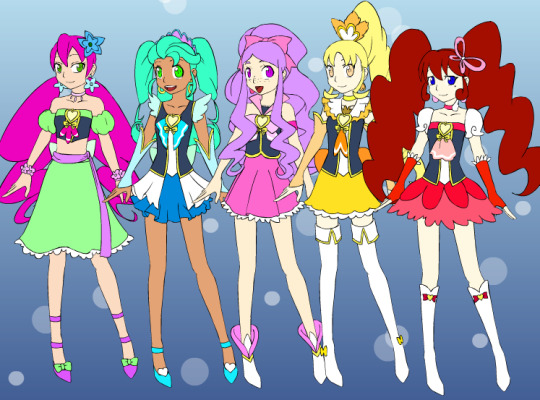
their first appearance, done in the happiness charge character creator in july 2019. left to right is splash, ocean, coral, shell, anemone.
unfortunately, none of them ever got individual glitter cure versions and aside from splash i don't draw them very often (and even with splash it's usually her in her civ form). i do have a drawing of splash in a photo of a draw the squad from 2022 (i believe it was 2022 i took the photo a long time after i drew it). i love draw the squads. i should do another one it's been way too long
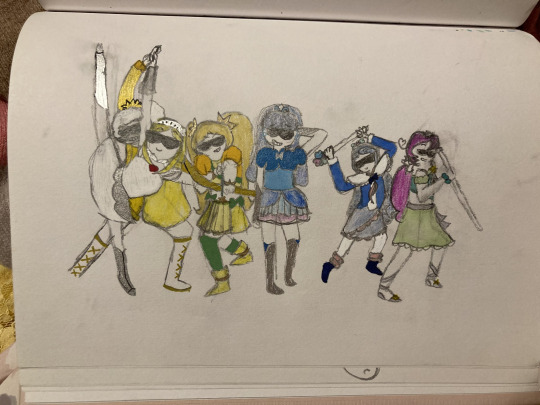
borealis is in this one as well, right next to splash (splash is on the right in green, borealis is the blue one), which is a nice segue into our next fanseason
northern lights precure:
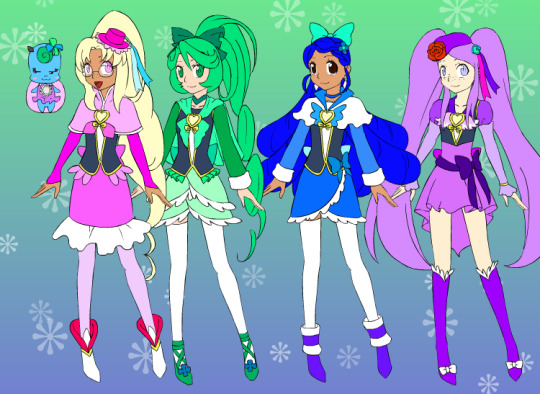
as mentioned before, northern lights actually predates the others (aside from moderation) by quite some time! i think what happened was i made them for fun, then forgot about them to focus on moderation again, and then dug them back out once i started making other fanseasons. this image is dated january 27, 2018. left to right we have aurora, shimmer, borealis, and glow
i really liked borealis's design, so she's actually got a few art pieces (unlike the others, who still sadly don't have solidified cure designs aside from their hair)
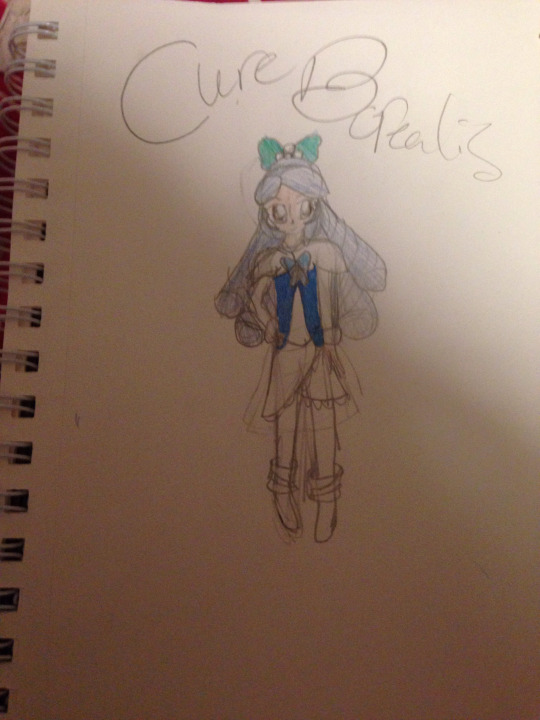
an in-progress borealis, done the same day as the character creator. i also tried making her a puzzlun cure card but i don't have a photo.
theatrical:
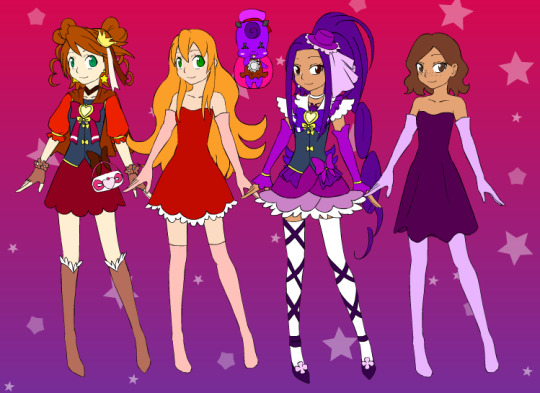
my beloved hacha creator shows up again. this is dated july 11, 2018, which is a lot older than i initially thought it was. theatrical was another one of those "create a team based around aesthetic and designs i think look neat and then do nothing with them afterwards until i shoved them into a lineup once i realized how many fanseasons i was piling up". this one does feature their civilian forms, which is unique! left is cure curtain and the right is cure spotlight. they stay a duo
desert sun:
poor desert sun didn't even get a character creator image. they have finalized civilian designs but not cure designs. the closest i can offer are these:
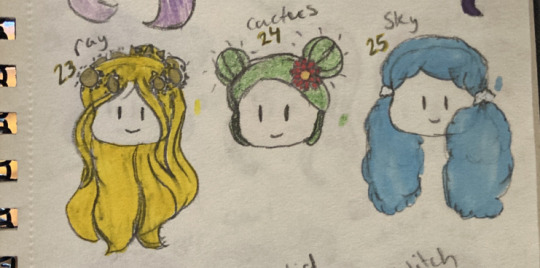
prototype hairstyle designs from march 2022

more finalized designs from a super smash bros (but it's my precures) character select screen thing i did in april 2024
supernatural:
supernatural has the same problem in that i didn't ever make a character creator thing with the full team. i think the first time they show up visually is from that same hairstyle piece as desert sun:
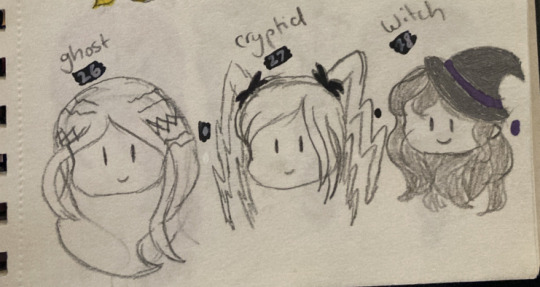
i unfortunately don't have a photo of moth from this set. she was on the next page. the reason this photo exists at all is because i sent it to myself as a reference for that super smash bros but precure thing, so i could use it as a reference for the hair of the cure i was drawing or go "oh that's kind of ugly actually" and create a new hairstyle. unfortunately for moth, she was on a page that only had 2 other cures and i have hers + those 2 other cures' hairstyles memorized so i didn't bother sending myself the reference

in april 2023, i tried making ghost in the glitter cure maker
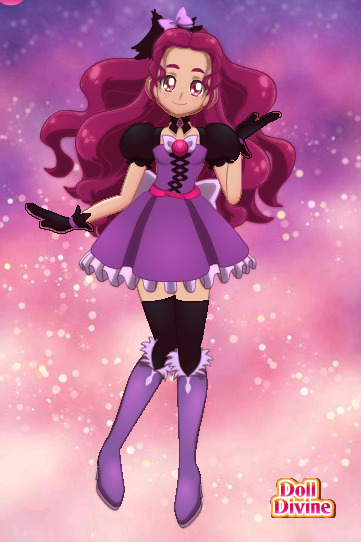
and witch a few days later. no cryptid or moth, i think i lost steam after this
BUT they all have traditional art refs from around the same time. which i don't have with me now, because - say it with me - the sketchbook they're in is at home and i was a dummy who didn't think about taking a photo to make sure she always had the references with her even if she couldn't access the sketchbook

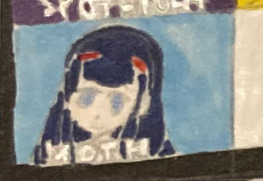
they do show up in the smash cures character select!
bonus: modpre in the hacha character creator from july 2018 because at the time no cure was immune to being made in it. i found this while searching for everything else. i'd completely forgotten about it
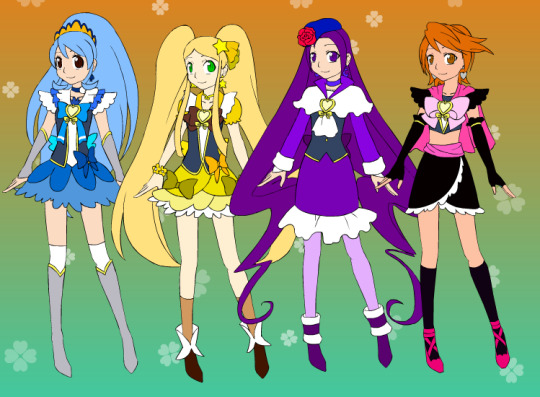
#splash shows up a lot in my sketchbook in her civ form#because she's a massive hater (affectionate) and so she gets a lot of the more aggressive incorrect quotes i find#you can always Tell when a cure team of mine originated in the hacha creator LMAO#their bodices often follow the same design pattern#precure#pretty cure#shining hearts precure#mermaid jewel precure#northern lights precure#theatrical precure#desert sun precure#supernatural precure#justie's fanseasons#justie attempts art#long post#not all of these are finalized. it has been 5 years and i am still trying to figure out a cure cryptid design
9 notes
·
View notes
Text
A Glimpse Beyond Grief: Chapter 1

Characters: Toji Fushiguro x Reader | Office AU | Both characters are in their early 30s | toji is good daddy in this uwu
Synopsis: galactically intertwined journey of two souls: one navigating the depths of loss, the other offering a beacon of healing. through witty banter and unspoken connections, they find solace in unexpected places, uncovering the resilience of the human spirit and the power of love to mend even the most shattered hearts.
Content warning: profanity, (eventual) smut, highkey adult themed, can be psychologically and emotionally triggering for some so read with caution.
A/N: there might be a few typos. will fix them once i get home later :D
--
Toji's integration into JJK Holdings marked the beginning of a positive turn for the company. His initial weeks on the job showcased not only his professional prowess but also his ability to seamlessly blend into the workplace culture. Armed with a wealth of experience and a versatile skill set, Toji quickly established himself as a valuable asset within the organization.
From the outset, Toji's work station was strategically placed right beside yours, a deviation from the conventional placement of executive assistants. This unique arrangement was a deliberate choice aimed at fostering efficient communication and easy accessibility.
The camaraderie between you and Toji flourished effortlessly. The rapport that began during his final interview continued to evolve positively. Both of you displayed a natural inclination for engaging conversations, creating an atmosphere that transcended the typical professional hierarchy. Toji, in particular, appreciated the pleasant surprise of a welcoming lunch on his first day, a gesture that left a lasting impression.
In the short span of a few weeks, Toji's impact on the company became palpable. Beyond his exceptional work outputs, his insights into critical business matters proved invaluable. This was evident in the recent town hall meeting where the Chief Human Resources Officer shared the news of a doubling in overall revenue for the previous month.
The positive momentum extended to JJK Holdings' first face-to-face event since the onset of the pandemic. Toji's involvement in the event planning proved instrumental, contributing significantly to its success. His presence didn't go unnoticed, as distinguished guests recognized him, leading to fruitful networking opportunities. Three guests were so impressed that they decided to form strategic partnerships with JJK Holdings, culminating in the signing of two partnership contracts just a week ago. Notably, one of these contracts involved Gojo Enterprise, a major player in property and real estate development led by Gojo Satoru, last year's most influential business tycoon in Asia.
Toji and Satoru's history goes way back to their college days, where they both vied for the title of their alma mater's most outstanding pupil. The dynamic between the two was vividly on display at the recent event. Picture this: you're with Nanami Kento, your Associate Director from the learning and development department, when Satoru's voice echoes across the venue, calling out Toji's name. Cue the nerve-wracking jump scare. Initially, you thought a fight was brewing, only to discover that it was just their peculiar way of interacting – a mix of banter and wrestling, to be precise.
Knowing Satoru's penchant for bickering, you should have seen it coming. After all, you and Satoru share a history from your master's degree days at the same school. Toji, despite his displeasure, didn't back down. Instead, he pulled Satoru into a headlock, leaving onlookers both horrified and confused. Satoru, in his typical fashion, grinned like a madman while being manhandled by the visibly muscular Toji.
The second company to approach you wasn't after a partnership but sought to leverage your organization's services. Ms. Ieri Shoko, Founder, and CEO of CureWave Pharmaceuticals expressed interest in tapping into your talent acquisition expertise to aid in their expansion across Japan and other parts of Asia. Interestingly, Shoko is more than just a business contact; she's a childhood friend. In your earlier years, you contemplated a career in healthcare, a path Shoko embraced. However, your journey led you to oversee a human capital solutions company, a role uncertainly assumed, but one you inherited through your grandparents. JJK Holdings, established by them, became your responsibility upon your grandfather's passing. His trust in your skills, coupled with being his favorite grandchild, added a layer of significance to your role.
As the Executive Director in your third year, the organization has already soared under your leadership. With Toji now at your side, the potential for further growth feels limitless.
"Hey, Toji, mind if I ask you something?" you called out from your desk, amidst the task of arranging a meeting with your group heads.
"You're already asking a question," Toji retorted playfully. Without looking, you could almost picture the smug smirk he wore, prompting a playful eye roll from you.
Amidst crafting an email blast for event attendees, Toji's concentration broke with the sound of your voice. The email aimed to express gratitude and nurture potential collaborations by promptly reaching out to leads. You had instructed Toji to compose it, pending your approval for scheduling at the most opportune time.
"So, what's on your mind?" Toji inquired, stretching from his desk after finishing the emails.
"Before joining us, you applied to other companies, right?" you queried.
"Yeah, I did. Why?" Toji replied.
Tilting your head, your lips formed a pout of mild confusion. "Well, you mentioned that it took you five months to secure a job here. It's a bit puzzling considering your impressive credentials and the fact that esteemed business leaders know you and hold you in high regard."
Toji chuckled. "Well, the companies I applied to couldn't meet my salary expectations, or a handful of them thought I was overqualified. They appreciated my qualifications, but when it came to negotiating compensation, they hesitated to match my preferred amount. Truth be told, I actually undersold myself when applying here, just so I could finally land a job."
"Wait, really?" Your voice carried a note of astonishment as you processed his revelation.
Toji leaned back, a sheepish grin crossing his face as he shrugged. "Yeah, really. I guess I was just tired of the constant rejections and decided to take a chance here."
You shook your head with a mixture of disbelief and amusement. "So, you basically tricked us into hiring you for a bargain?"
His laughter filled the air, a warm and genuine sound that lightened the atmosphere. "Well, 'tricked' might be a strong word. Let's just say I saw an opportunity and seized it. And I've got no regrets."
"Unbelievable," you chuckled, shaking your head once more. "I can't decide if you're audacious or clever."
"To be fair, it worked out well for both parties," Toji remarked, his tone still lighthearted. "I landed a job, and you got yourself a skilled team member."
Leaning back in your chair, you wore a thoughtful expression. "True. But just remember, Toji, next time we negotiate your salary, I won't let you get away so easily."
Toji raised an eyebrow playfully. "Oh, really? And here I was hoping for a lifetime of discounted employment."
The air was light with laughter, the bond between you and Toji growing with every shared moment. As the laughter subsided, Toji's playful demeanor shifted, and his expression turned earnest. "I owe you, you know. You saved my ass."
You tilted your head, a mischievous grin playing on your lips. "Consider it part of the 'discounted employment' package: endless gratitude and the occasional coffee run for the boss."
Toji's eyes widened in feigned shock. "A catch! I knew it. But a few cups of coffee are a small price for salvation."
Another burst of laughter echoed in the room, creating a momentary bubble of warmth. When it settled, you rose from your chair, stretching fatigued limbs. "Speaking of coffee, it’s midday. Care to join me for a cup?" you proposed, approaching his desk.
"Sure. Just need to wrap up this draft," Toji replied, his focus on the monitor. You positioned yourself beside him, your arm casually draped over his office chair, and your gaze fell upon the email drafts. A smile danced on your lips. His eloquence shone brightly in his words.
"Hey, big guy, you've got a typo right here," you observed, pointing out the minor error.
"Woops. Don’t deduct that from my paycheck. I’ll do better next time, boss." Toji joked, earning a playful smack on his shoulders from you. Laughter spilled through the office, infusing it with a comfortable warmth.
"Oh, you can be sure I'll be cashing in that favor at the most unexpected moment," you declared, a playful lilt in your voice.
Toji chuckled, a glint of mischief in his eyes. "I'll be ready and waiting, boss."
With a final shared grin, you both headed for the office exit. The break room was close, and the idea of a hot cup of coffee was too tempting to resist. As you walked, conversation flowed effortlessly from work matters to lighter topics, deepening the camaraderie.
In the break room, you both fixed your preferred brews, the coffee scent filling the air as you leaned against the counter. Toji took a sip, visibly pleased.
"This is the real fuel that keeps me going," he quipped, nodding at his cup.
You raised yours. "To caffeine, the unsung hero of productivity."
Cups clinked, laughter followed. Even with the gloomy weather outside, the cheerful vibe persisted. Amidst sips, you found a brief respite from work.
"I hope the rain stops soon. It’s been raining for a while, right?" you observed, looking at the raindrops against the window. Toji agreed.
"Yeah, I'm hoping for that too. Traveling is a hassle in the rain. Traffic becomes unbearable, and I end up getting home late," Toji shared, a touch of discomfort in his expression.
Curious about his family life, you asked, "When you work on-site, who takes care of your kids?"
"My in-laws. They're nearby, so they help with the kids when I'm here."
Nodding, you said, "It's nice that you have a good relationship with your in-laws."
"I owe them a lot. They took care of Megumi and Tsumiki when I was still grieving over my wife," Toji shared, taking another sip.
A warm smile appeared as you asked, "You have two daughters?"
Toji chuckled and shook his head. "No, I have a daughter and a son. I named him 'Megumi' to signify his role as a blessing in our lives. It might sound sentimental, but during my wife's pregnancy with him, there were more challenges compared to when she was expecting our daughter. The doctor mentioned a high risk for both him and my wife. He was also born prematurely and had to spend some time in the NICU after his birth."
As Toji delved into his personal life, his gaze became distant, as if he were revisiting memories, both joyful and painful. His storytelling held an inexplicable allure, captivating you. You felt drawn to his narrative, like a moth to a flame, and in this scenario, Toji was the flame.
Attempting to suppress the fluttering butterflies proved futile; the more you resisted, the stronger your heart's rhythm echoed, amplifying the emotions welling up inside you as you looked at your right-hand man. It wasn’t entirely your fault – the guy was undeniably attractive. His face, his hair, and, oh god, his physique. You had to avert your eyes during his final interview. And his voice? Unbelievable. You didn’t mean to ogle at somebody else’s husband, but damn.
Meanwhile, Toji grappled with a whirlwind of emotions—longing, shame, sadness, hope, and confusion. His wife remained a sensitive subject, yet he found himself freely discussing her with you. It was only the second time her name had come up in your conversations, yet there was a growing sense of comfort in sharing his feelings with you.
Toji spent a significant amount of time deciphering the emotions within him. He concluded that what he felt towards you was akin to the "suspension bridge effect." Amidst grappling with depression, grief, and a string of job rejections, you emerged as his unexpected savior. You became the catalyst that propelled him from point A to point B. Not that he was financially destitute during his unemployment period—quite the opposite. However, successive setbacks left him grappling with a sense of inadequacy.
In essence, you helped him put his life back in motion.
However, even after settling on this conclusion, he couldn't deny the palpable connection between the two of you. Toji was certain that you felt it too. Yet, like him, you were navigating the maze of your own emotions. For all he knew, you had your own personal circumstances. But when the day arrived for both of you to face each other and your burgeoning feelings, Toji was more than willing to explore that with you.
"How old is Megumi now?" you inquired curiously. Toji responded with a gentle, paternal smile: "He's turning eight in three months."
"Really? Can I..." Your voice trailed off, gradually growing softer. Toji noticed the change and turned his gaze toward you, silently encouraging you to continue. Meeting his eyes, you found the strength to speak once more: "Can I give him a birthday gift?"
"Absolutely, you're more than welcome to," Toji chuckled, placing his empty cup aside.
You smiled and said, "Please tell me what he likes, so I can get the right gift for him."
"Try books. He loves to read," Toji said, then shortly after, a laugh slipped through his lips as he thought of something about his son, "From the amount of content he’s consumed through reading, he’s becoming a smartass by the day, though it’s also safe to say he got that part of his personality from me."
"Oh, I wouldn’t be surprised," you teased, earning a cheeky squeeze on your sides.
If it weren’t for your lightning reflexes, you would have coffee spilled all over you. "Hey! Watch it!" You said to him, but your tone and delivery sounded anything but annoyed.
If anything, the gesture made your heart jump. In just a short period of time, the two of you became so close that you're comfortable poking each other and addressing one another without any honorifics. The line between superior and subordinate has vanished. It's not that you're uptight about superiority, but rather that your relationship has evolved beyond traditional hierarchies.
After the incident, something clicked, and you realized that the crush you've been harboring for Toji had finally taken hold. Much to your dismay (or not.) His demeanor that day completely enchanted you, and it's fair to say he effortlessly charmed his way into your heart without even trying.
The question now is: will you act on these feelings and pursue him?
The honest truth is, you're not quite sure, at least not yet. It's clear that Toji still holds onto the memories of his late wife, and you want to be respectful of that. At this point, you believe it's best to let things unfold naturally and see where life takes the two of you.
"So, you're ready to go back?" Toji inquired, turning to you after washing his cup.
You nodded and rinsed yours as well, saying, "Yup, let's head back."
After a much-needed caffeine refill, you both returned to your office to resume your tasks. Engrossing conversations about everything under the sun filled the day. Time flew by rapidly as you became absorbed in both work and dialogue. When you eventually checked your phone, it was already 5:00 p.m.
Toji stood up, stretching for what seemed like the umpteenth time that day. "I hope the traffic isn't too bad," he commented, glancing out the window to check if the rain had stopped, thankfully finding that it had.
"Perhaps you should consider moving closer to the office," you suggested as you organized your belongings. "That way, you won't have to worry about heavy traffic or long travel times."
"I am considering that, but the kids are still in school," Toji replied, "so I might have to wait until the school year's over before we can move."
"I suppose moving abruptly would also stress them out."
"Yeah, that's another factor. Well, are you ready to go?" Toji asked, standing by the door while waiting for you to finish gathering your things.
"Yeah, let's—"
"Y/N."
A deep, commanding voice suddenly resonated within your once peaceful office. Upon hearing it, you stood frozen in place, your heart racing for all the wrong reasons, all of which didn't go unnoticed by your executive assistant, and his eyes trailed to the man standing by your office door.
After a few seconds, you begrudgingly decided to acknowledge your visitor.
"Kenjaku."
#warabidakihime#jujutsu kaisen x reader#jjk x reader#jjk smut#toji smut#toji x you#toji x reader#toji fushiguro smut#toji fushiguro x you#toji fushiguro x reader#jujutsu kaisen smut#jjk headcanons#jjk imagine#jujutsu kaisen headcanons#jujutsu kaisen imagine
112 notes
·
View notes
Text
How Crasona talks to the crew
Crasona: Captain I’ve assembled a capability commands for the shipment process to accessible technological solutions for when the ship faces some form of disruption.
Curly:….You don’t have to be formal…
Crasona:….Why would I want to associate with you?
Curly:……You wanna try that again?
Crasona:…..apologies, let me rephrase. Why the heck are you trying to be my friend?
Crasona: Daisuke if you wish to improve, don’t try to fit Swansea’s standards, try a new angle.
Daisuke: *nod* Okay
Swansea: Crasona whatever you told him, it sorta worked…sadly he’s a gooner and a goofball.
Crasona:….Damn we got a fuckboy?
Swansea: NO! WHAT IS WRONG WITH YOU?
Crasona: My bad OG.
Swansea: I’m not your little friends, don’t do that.
Crasona: *snickers while Swansea laughs*
Anya: Crasona you can’t stay up late to send coordinates, every two hours. It’s unhealthy and I’ll have to set a procedure for you….
Crasona:……..
Anya: Um….
Crasona: Sorry…I understand, just probably will find a loophole so I’ll be sure to avoid doing it so late.
Anya: Thank you.
Crasona: No problem doc…
Anya: Um, would you like to listen to some music?
Crasona: Yea, yea…..I really miss her.
Anya: Sometimes we have favorite people we obsess over. No worries.
Crasona: *walks past Jimmy*
Jimmy: Crasona.
Crasona:…..*slow turn*…..
Jimmy: Ya mind warning me before you do anything with Curly?
Crasona:……Are you Captain?
Jimmy: Well no-
Crasona: Then why the funk would I listen to you? Anyway, food will be done in two minutes. *leaves*
Jimmy:….*salty because he wanted to talk more*
Second interaction with Jimmy
Jimmy: Crasona Curly said we should try to get along.
Crasona: *tapping on panel*….
Jimmy: So…
Crasona: Yeaaaaa I’m not buying it, you want to see me ignore you?
Jimmy: Whatever, you can act like that all you want.
Crasona: I sure will.
Curly gets involved
Curly: If you two can’t get along I will make you both sit together whenever we eat.
Crasona: On gawd Curly imma- *inhale*
Jimmy: They’re being stubborn.
Curly: Try to compliment each other.
Crasona:….Your existence is comparable to dirt….
Curly: MS. BLANK!
Crasona: What I’m being nice, dirt creates life, trees and flowers.
Jimmy:…..You’re a bitch.
Curly: JAMES WHAT THR FUCK GUYS!
Them: *shook cuz he got mad so they start shaking hands*
Later
Jimmy:……..My bad
Crasona: No no, my apologies….
They are both afraid of Curly, Crasona however got attracted to that and wanted him to body them.
(Attracted in a psychological thriller sense, Crasona is more infatuated with death than people)
(This is my perspective of Curly when it snaps at Jimmy during the crash but ya know he doesn’t physically do anything. I feel like if Curly had the chance to he’d manhandle Jimmy, and I feel like it’d scare him because he’s used to stepping all over Curly verbally. But we never notice him do it physically until Curly cannot defend himself. Basically I think Curly is super strong, doesn’t know his strength and probably accidentally flexes off which scares Jimmy)
#mouthwashing anya#curly mouthwashing#swansea mouthwashing#daisuke mouthwashing#mouthwashing#mouthwashing oc#mouthwashing swansea#mouthwashing jimmy#jimmy mouthwashing#anya mouthwashing#mouthwashing curly
8 notes
·
View notes
Text
A couple of weeks ago, I posted an article on how the fundamentalist movement, in the past, committed acts of fraud disguised as science. I talked about how they’d done so for decades, I talked about their intent and their methodologies, and how they have been adopted over time by the right in general.
I then applied this to the Cass Report, the “report” used by the Tory government in Britain to ban most forms of trans medical care and by American rightists to both deny health care and pass laws against trans people. I showed how exactly the same recategorisation and data selection methods were used to de-rate almost every study on youth gender transition, so that they could create a report which claimed there were “few to no high quality” studies on the matter.
I said I didn’t know for sure this was the same sort of ill intent, or that they happened to be doing the same thing as fundamentalists and rightist have been doing for the last many decades. I couldn’t prove that’s what they were doing, I could just demonstrate that it looked awfully, awfully similar, as in, exactly the same.
Whelp, looks like we can prove that ill intent now.
The Cass Report describes Dr. Cass as “a senior clinician with no prior involvement or fixed views in this area.”
This is a lie.
Not only had she met with American politician Ron DeSantis to aid his efforts to ban gender transition, turns out she was recommending the so-called “gender critical” hate screed, Irreversible Damage, which compares gender transition to the Holocaust.
She also, turns out, included studies to argue against trans health care that are not only outdated and fail to meet her own theoretical standards, but which have been out-and-out discredited.
Again: it all comes down to picking the data you want to get the result you want, and that’s exactly what she and her team did.
Talking of the team, some of the other people appointed to work with her on the report were also active in anti-trans/anti-queer politics, including lobbying against ending “conversion therapy” and helping Republicans with bans on trans health care, serving as “expert witnesses” in favour. Tories have now admitted the group was salted with “gender critical” activists specifically to “expedite” the work, while trans people were explicitly excluded.
Erin in the Morning has all the details, as do Drs. Max Davie and Lorna Hobbs in a report they have kindly also placed in Google Docs for better public accessibility.
The Cass Report is a rightist political document disguised as a scientific work, with better cover than, say, the work of Dr. Paul Cameron, but with no better scientific validity or intent. If you don’t know who Cameron is, count yourself lucky. Or read my M&Ms post, the same one I linked above. Either will do.
This was a hatchet job and a work of hatred used to both condemn and deny medical care to people who desperately need it, and it is yet another lie that must be exposed, and another fraud about which people should know.
It is, once again, yet another goddamn lie of the right.
87 days remain.
10 notes
·
View notes
Text
instagram
It all started here. I woke up and looked at 'my' Discord server for the bloated tic of a fanfic (hey that rhymes, neurospicy two seconds!) I write with my partner SonaBeanSidhe, Aran Thranduil's Dining Hall. There hadn't been enough tea yet so the natural response was 'wth is this?' Well, THIS was going to Hoover my next two days and counting. Just visit the post, dear friends of the writing persuasion and you would see (I'll save you time because I'm nice this way) that there are many screenshots supporting just what the meme says: This Instagram OP knows a writer who found herself in a steaming pile of mess with the Google Docs TOS (which is really also the Google Drive TOS, making it somewhat difficult to locate said TOS. I'll save you more time. Here:
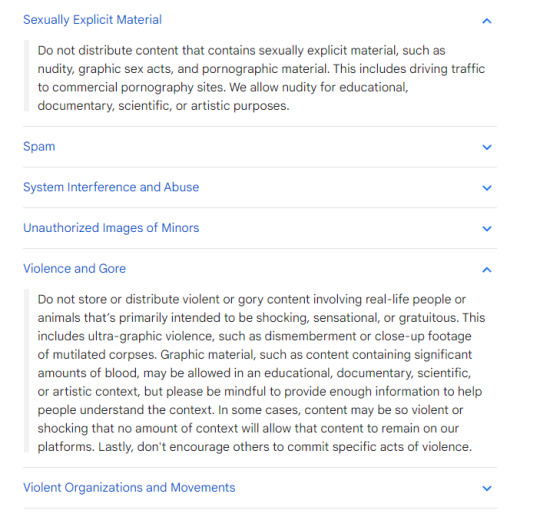
This information comes from https://support.google.com/docs/answer/148505#zippy=%2Csexually-explicit-material So, it was the act of sharing the files, not having created or stored them that triggered what had happened. Okay, still not reassuring. In the meantime, I was concerned enough to post what had happened to r/FanFiction. Within minutes, my post had been frozen by the mods there. I can see their concern. I believe they had only seen the meme-like first screen of the Instagram post, and it does come off like a bad Snopes Fail. They asked me for more proof. The first thing I did was a search for previous instances of Google having frozen Drive accounts previously. They are limited, but they exist. The concern here had to do with the current lack of information as to why the action happened, and whether we who collectively authored and had shared Docs with explicit content were about to have our Drive accounts fall before the scythe of an overzealous AI rollout on the part of Google. Which led to the second part of this. My first response to the mods was as follows:
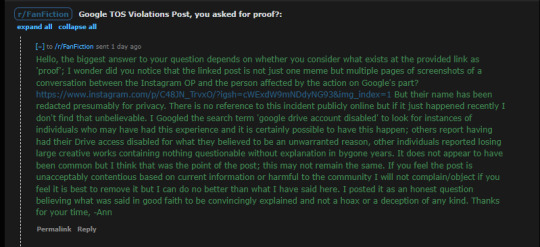
A little while after I sent this, an update appeared on the Instagram OP's account (easy to find) so I added this:
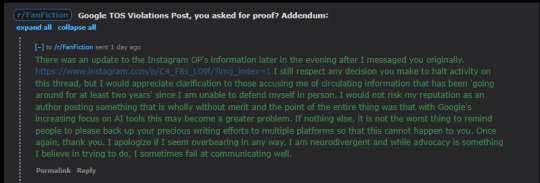
The salient point of the update was that the author had received restored access to her Drive, but NOT the Doc that had started the entire difficulty. I waited for a response. And waited, and waited. In the meantime, I had no means to add to, respond to, anything to my original post or defend myself against some fairly sharp initial criticisms leveled against me by individuals who clearly hadn't read anything beyond the initial meme. Special. While I understand a sub this large likely has a lot of messages to field, I also felt that given they managed to freeze my post in a matter of minutes, they were really taking their time responding. So I weighed in on Instagram with a message of support. If nothing else is taken away, please take this: Back up your files. It's easy to create an alt Google account; this other account will have its own Drive storage. Share your folders and files with yourself. If you don't already realize, in Docs under the File dropdown menu the third option is Make A Copy. If you have shared the original document 75 times, you won't have shared that copy at all. Consider backing up your works to Indie platforms like Get Hermit, Ellipsus and The Quill. There may be others. Your own external hard drive is also a very good idea. But wait, you ask. What about just using MS Word, or having copies as a PDF file in the Adobe cloud? Not so fast, my friend. Look at Microsoft and Adobe's TOS regarding sexually explicit content...you'll get an unpleasant surprise. I did. In the meantime, a third update came from the OP on Instagram shedding far more light as to what had likely gone wrong. She had shared the Doc with she guessed 18-20 people as beta readers. The belief is now that one of these persons actually turned her in to Google via their abuse form. To quote one of the commenters on that update: "I heard from an agent that Google will only do this to your account if someone reports it. Google isn’t scanning docs for explicit content (except maybe images), but yeah, for this to happen, someone had to report her document to Google." This felt like a relief...and yet is still packaged inside a cautionary tale. How many of us have shared by 'whoever has this link'? I have, or rather, I had. I revoked all such permissions to all large stories and folders in favor of my few trusted long-time friends and beta readers. The works are on AO3. I don't need those Docs links to be free floating all over the place, not after seeing what can happen. I was on vacation in England some years prior when I realized I had lost the ability to send out all outgoing Gmail. It took me several days to figure out what had gone wrong and nearly lost me my ability to receive Covid test results at a time when that was a travel necessity...almost disastrous. Fortunately I had multiple email accounts and could work around the problem. Which brings me to the last of this.
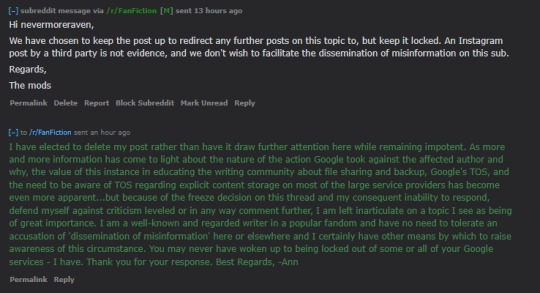
While including the subreddit mod's responses here may seem retaliatory/petulant on my part...I'm at best miffed at their shortsightedness, maybe mildly insulted, mostly shaking my head at the fact that there is something to have been learned here that could have affected any one of us. No one was spreading misinformation. Something had indeed happened. The source of it had been unknown at the time of posting. Had they left my post alone I would have gladly redacted as it unfolded; the reason for placing it on that sub was not to create a giant stir but to let others know of the risk of this happening at all and to encourage backing up that which most writers invest a considerable amount of their emotional well-being; the safety of their written works. Yes, I'm neurodivergent. No, I don't always see the world as others do. No, I still don't think this difference allows the response to be interpreted as much other than a slight and working against the interests of authors (I'm on their side and last I checked, readers need the authors to have the things that are written in order to have the things to read. Just saying). Whatever, what really matters is, if you feel this is worth sharing, share, take away the important bits, and if someone out there just wants to write it up in 3 sentences so it isn't a tl;dr, do that too.
Have a Googly day, to all near and far, in these times in which we live...>.>
#google docs#google drive#terms of service#writing#fanfic#slash fanfiction#smut fanfiction#service provider#beta reader#Instagram
13 notes
·
View notes
Text


Top: image from Folio 76r of Walters Ms. W.269, a Catholic Book of the Hours created in the mid-1400s for a woman named Collette. In this image, Collette herself is depicted praying to the Madonna and Child. Bottom: three different piles of identical books.
A growing field of scholarship is examining texts as materials and cultural objects. Scholars are thinking about how recorded texts appear in concrete forms — scrolls on parchment, bound codices on paper, magazines on cheap glossy paper. These scholars emphasize the ways in which technology and knowledge-transmission are intimately connected to one another. […] Broadly speaking, there are three interrelated factors that can explain the material form which the written word takes.
The materials and technology available to produce and distribute texts: People can only record written texts with the materials and technology available to them. For example, the invention of paper decreased the price of the written word and enabled more text to be available to more people, with wide cultural implications. Cheap ball point pens encourage things like jotted down note-to-self.
Economics and the market for knowledge and education: Who will pay for text, how will that money or those goods be moved from place to place, and who stands to earn a profit from creating and circulating those texts? In the middle-ages, for example, written texts were less common than today and much more expensive, but an individual patron had more leeway to individualize the written text, since he (or, occasionally, she) could order what he wanted from a scribe and artist. In contrast, book buyers today have greater and cheaper access to printed works, but the format is hardly individualized at all due to constraints of the mass market.
Cultural assumptions about what one does with words: Some texts are meant for slow study, others for quick reading, and still others for long-term storage or record keeping. The material form that the text takes will depend on cultural expectations about what will be done with words once committed to writing. A receipt from a cash register -generally to be thrown away or at most saved briefly- will appear in a material form different from a university-course textbook, with an expectation (not always fulfilled) that students will read carefully and prepare for papers and exams. A newspaper takes on a material form different from a non-fiction book, even when reporting on the same topic, due to different assumptions about how the reader will treat those printed words.
Mass-market newspapers are a fine example. Cheaper paper in the nineteenth century and advances in print technology that lowered prices enabled mass-market newspapers and made it possible to imagine large quantities of disposable written materials. Technological changes in shipping and distribution of both words and knowledge, such as the telegraph and the railroad, helped knowledge about current events reach further more quickly, so reporters could produce texts and distribute them quickly to a far-flung audience. The spread of literacy helped create a large population of consumers, which made the newspaper a potentially profitable commodity to produce. Shorter articles scattered on a page with large-print headlines, as well as illustrations, and later photographs, enabled consumers to learn about many diverse topics and to take in as much detail as they felt like they had time for.
Yoel Finkelman ("From Bomberg to the Beit Midrash: A Cultural and Material History of the Talmudic Page Layout")
4 notes
·
View notes
Text
Is Marvel the Ultimate Gen Z Universe?
Marvel has been a fan favorite in superheroes for decades, from comics to movies. From the diversity in superheroes to the addictive, intertwined, complex storylines - it's more than unforgettable battles and crazy visuals but a universe that shadows values, struggles, and dreams.
The Marvel Universe contains so many things that fans love and appreciate, such as the diversity of characters ranging from Ms. Marvel, Black Panther, and Shang-Chi, which brings people from different backgrounds and lets them understand the characters, their journey, and how someone like them can be seen on the big screen. People Matters Global writes, "By leveraging diversity & inclusion for enhancing innovation, Marvel created an inclusive cinematic universe showcasing a wide representation of society." This shows that Marvel values inclusivity, and they took charge knowing that fans appreciate seeing people who reflect themselves on the big screen. This, in turn, allows fans to feel more empowered.
Also, Marvel has created a vast connection with people worldwide who can share this part of themselves with others. Whether these fans are discussing theories, discussions, or even cosplaying, Marvel allows people to connect with those interested in the same things. Every character in Marvel and their stories has their own unique and exciting journey that fans can not get enough of. Storytelling is powerful and can inspire readers, watchers, and more, to embrace their power, potential, and culture.
However, the Atlantic writes an article on how it is harder to enjoy the comics for first-timers now since they are hard to obtain, "It breaks my heart, but I think that Marvel comics (and DC, the other of the two largest comic-book publishers in the country) are the least accessible form of popular entertainment out there. The challenge to becoming a new comic-book fan is untangling the convoluted web of stories that happened before you picked up your first book." Though this may be true, Marvel does an excellent job of making sure the films are connected so that if someone is first getting into the franchise, there is a way to understand it. Whether watching the films chronologically by year or, fans can also search on Google what order the movies are supposed to go, according to events (which is the best way to watch). Marvel does a great job at being open enough for newcomers to join the team even without reading the comics.
It is clear that Marvel isn’t just a franchise; it’s a cultural phenomenon that reflects the values and experiences of Gen Z. It creates a universe where we can see ourselves and find connections. So, whether you’re team Iron Man or Captain America, one thing’s sure: we’re all part of this incredible Marvel journey together!
4 notes
·
View notes
Text
Xylovitria
This post is an overview of one of the "animal" phyla present on Almud. This is the first of many, since I do plan on making a similar post for each of the others. All art shown here was created using MS Paint, though I may switch to a different program if I find one that works better (probably Procreate, since I have recently bought it, but it's a bit hard to use with just a finger on a phone screen) (Also MS Paint has an AI generator thing now and that's very stinky and bad).
The first thing to cover is how the phylum came to be. Xylovitrians originated as an offshoot of vivitrians, specifically a freefloating colonial species analogous to a hard, glassy man o' war. Its body was hollow, with pores lining its outside to allow water in to be filter-fed through by its tendrils. A color-coded overview of its anatomy is shown below.

Purple: The glassy shells of each zooid. Forms a pocket for water to flow through. Blue: Same as above, but in a different spot. I don't know why I colored this part differently, besides it being on the bottom. Too late to fix it sadly. MS Paint flattens layers after saving the image. Red: The soft feather-like tendrils of each zooid. Responsible for filtering nutrients out of the water that flows into its body. Orange: Also tendrils, but specialized for a different purpose. This thicker bundle not only filters through the water for nutrients, but produces gametes for sexual reproduction. Typically, though, the organism will just reproduce asexually by producing more zooids and splitting apart.
At some point very early into the history of Almudian life, a kelp-like plant species developed a habit of growing on top of these proto-xylovitrians, with their roots sometimes growing through the cracks and into the inner cavity. Here, the roots of the plant and the tendrils of the zooids would sometimes wrap around each other, forming a structure similar to Earth mycorrhizae. In a formation such as this, the animal would absorb some of the sugars from the plant's roots. In return, the plant would absorb some of the nutrients from whatever microorganisms got caught in the zooids' tendrils. This arrangement proved so mutually beneficial that this proto-xylovitrian species adapted an opening at the top specifically for the plant to grow through, and the kelp analogue adapted to only be able to grow on or inside xylovitrians.
The lineage did not stop developing here, however. One offshoot descendant of this proto-xylovitrian eventually adapted to live at the surface of the water, giving the resident plants much better access to the sunlight and gases necessary for photosynthesis. The plants, meanwhile, adapted to have sturdier stems and more water loss-resistant skin, as well as a new way of entering their host. The plants’ spores now enter though the side pores leading into the water cavity, where they will bloom without ever having lived outside. Below is a diagram of this new offshoot’s anatomy and what sets it apart from its ancestor.

Purple: Same as before, but with a thick, waxy coating on the outside to prevent water loss in the above-water level bits. Blue: Same as before. Nothing to comment on. Only colored this part in differently for the sake of consistency. Red: The inner zooids' tendrils have lost the ability to filterfeed. Instead, they get all of their nutrition from the plants' roots, which they are permanently wrapped around. The central cavity, despite being above water level, is also still filled with water, preventing the plants from dehydrating. The water is brought in through the side openings, which now also contain a pumping mechanism to prevent backflow. The entire structure is more or less a living vase now. Orange: Same as before, but with some added features. Not only are the tendrils longer, but some of them have developed the ability to produce toxins. A few toxin-resistant, fish-like creatures use these areas as a refuge from predators, where they will also pick up some gametes which they will spread to the next set of tendrils they hide in, inadvertently acting as vectors for the xylovitrians' reproduction. Yellow: A gas bladder, which lets the whole structure stay buoyant enough to not sink below the surface. Adapted from a mutated second central cavity.
Given that these are freefloating organisms, it was inevitable that some would eventually wash up on land, where certain adaptations, such as the waxy coating and the inner water cavity, would allow the xylovitrians and their plant partners to continue surviving and thriving. Without much risk of drying out, this small beached population continued reproducing on the muddy shore, gradually accumulating adaptations over the generations that made them even better at living on land. It is at this point that the first true xylovitrians emerged.

Below is yet another diagram, this time of a fully-terrestrial inland xylovitrian. The phylum's diversity exploded after the transition to land, so this isn't totally representative of all species, host or plant, but it's still a generally useful guide.

Purple: Same as before, but now there are sometimes additional openings at the top for the leaves of the plants to grow out of. Blue: The siphons that connected the central cavity to the outside body of water have become their own separate organs, accompanied by root tendrils outside of the tube to make absorbing water easier. Cyan: Rather than water, the central cavity is filled with what can be best described as a sort of nutritious goop. The plant gets all of its nutrition from here. Green: This gland is responsible for producing the aforementioned nutritious goop. Like the water extractor organs, these are specialized chunks of the central cavity. Orange: The larger bottom tendrils now not only absorb nutrients and produce gametes, but root the colony into the soil. These nutrients are used to nourish both the xylovitrian and the plants. Other than that, they have remained mostly the same, just more spread out. Yellow: No longer necessary for flotation, the gas bladder now functions mostly as a lung.
Unfortunately, the new arrangement of parts, with the genital tendrils and water tubes both being underground, makes the old reproduction and ensporification method impossible. Fortunately, a new method was devised to replace it, allowing the phylum to live on.

Step 1: The plants and xylovitrians are fertilized individually of each other, with the plants exchanging gametes through the air on swirly reproductive branches and the xylovitrians doing so under the ground with extensions of their roots. Step 2: An empty juvenile xylovitrian emerges from the ground, while the plants' reproductive branches develop large spores using the exchanged genetic info. Step 3: One or a few of the plants' spores fall, float, or otherwise enter into the empty xylovitrian, aided by feathery extensions that catch them if they fall close to the brim. Upon reaching the goop pool within, they will germinate, signalling the xylovitrian to continue its development. Step 4: The new organism pair has been fully established, ready to one day do the same as their respective parents.
Notably, this specific method allows for different species of guest and host to mix and match, since different pair types are often similar enough to be compatible. This is not possible with every species, but it's a common enough phenomenon to where it's worth mentioning.
This is not the only dispersal method that exists, though. One group has adapted to be able to merge the xylovitrian embryos and plant embryos into a single seed, suspended in a sugary slime with a consistency and flavor similar to that of fruit gummies. Admittedly, I haven't fully thought through the mechanics of how this works, so I'll have to revisit it later. Until then, here's a very basic diagram.

Purple: Xylovitrian embryos Blue: Plant embryos
I may edit this post later to add on or revise details if I feel like anything could be improved. I will also almost definitely make individual posts for specific species or families of xylovitrians that I feel like showing off. This is the end for now, though.
#Almud#art#spec bio#speculative biology#spec evo#speculative evolution#alien#aliens#xenobiology#long post#VERY long post#my art
6 notes
·
View notes
Text
MS Office - Introduction
Microsoft Office is a software which was developed by Microsoft in 1988. This Office suite comprises various applications which form the core of computer usage in today’s world.
MS Office Applications & its Functions
Currently, MS Office 2016 version is being used across the world and all its applications are widely used for personal and professional purposes.
Discussed below are the applications of Microsoft Office along with each of their functions.
1. MS Word
First released on October 25, 1983
Extension for Doc files is “.doc”
It is useful in creating text documents
Templates can be created for Professional use with the help of MS Word
Work Art, colours, images, animations can be added along with the text in the same file which is downloadable in the form of a document
Authors can use for writing/ editing their work
To read in detail about Microsoft Word, its features, uses and to get some sample questions based on this program of Office suite, visit the linked article.
2. MS Excel
Majorly used for making spreadsheets
A spreadsheet consists of grids in the form of rows and columns which is easy to manage and can be used as a replacement for paper
It is a data processing application
Large data can easily be managed and saved in tabular format using MS Excel
Calculations can be done based on the large amount of data entered into the cells of a spreadsheet within seconds
File extension, when saved in the computer, is “.xls”
Also, visit the Microsoft Excel page to get more information regarding this spreadsheet software and its components.
3. MS PowerPoint
It was released on April 20, 1987
Used to create audiovisual presentations
Each presentation is made up of various slides displaying data/ information
Each slide may contain audio, video, graphics, text, bullet numbering, tables etc.
The extension for PowerPoint presentations is “.ppt”
Used majorly for professional usage
Using PowerPoint, presentations can be made more interactive
In terms of Graphical user interface, using MS PowerPoint, interesting and appealing presentation and documents can be created. To read more about its features and usage, candidates can visit the linked article.
4. MS Access
It was released on November 13, 1992
It is Database Management Software (DBMS)
Table, queries, forms and reports can be created on MS Access
Import and export of data into other formats can be done
The file extension is “.accdb”
5. MS Outlook
It was released on January 16, 1997
It is a personal information management system
It can be used both as a single-user application or multi-user software
Its functions also include task managing, calendaring, contact managing, journal logging and web browsing
It is the email client of the Office Suite
The file extension for an Outlook file is “.pst”
6. MS OneNote
It was released on November 19, 2003
It is a note-taking application
When introduced, it was a part of the Office suite only. Later, the developers made it free, standalone and easily available at play store for android devices
The notes may include images, text, tables, etc.
The extension for OneNote files is “.one”
It can be used both online and offline and is a multi-user application.
3 notes
·
View notes
Text

The Very Useful Watermark Feature
Whenever I bring up subject matter that involves procedures whereby the location of the feature has moved from one version of the software to another, you should know where it is situated from Version to Version of the software.
The Watermark is a very important feature that should be used to protect against wholesale copying.
Let's take a quick look at the Watermark.
If we choose to implement a watermark in MS Word, we make a decision whether we use a generic watermark such as "Confidential" "Client Copy" etc. or we can use a picture or logo type picture and finally we can use a "Custom Watermark" whereby we type in our own text such as our company name, website etc.
Note: Your Watermark will not print if you do not have the selection “Print Drawings Created In MS Word” checked. You can find this setting under File, Options, Display, Printing Options.
If we print out the file, the watermark will be visible on your hard copy. If we send the file in MS Word to someone and the file is not password protected, then someone can simply remove it. Finally, if we save the file as a PDF, then the watermark will be present in the PDF on its own layer. Again, it can be accessed and removed if you don't password protect the PDF file from editing. In Adobe Professional, this can be done under Tools, Advanced Editing Functions and choose -Touch-Up Object Tool. And one should remember the many programs that break the passwords set on both MS Word and Adobe PDF.
Keep in mind that the watermark can be implemented from the Adobe file since Adobe Professional and Nuance allow one to create a watermark in the newly created PDF.
In MS Word 2010, we find the watermark under the Page Layout Tab.
In MS Word 2013 and above, here is how to get to the watermark feature:
Click the Design tab.
In the Page Background group, click the Watermark button. A menu plops down with a host of predefined watermarks that you can safely place behind the text on your document's pages.
Choose a watermark from the long, long list or customize your own.
Note: To "flatten" the watermark so that it can not be removed! Using Adobe Professional or Nuance, In Nuance, look for the Advanced Processing Tab and select "Flatten".
In Adobe Pro, Click the Layers button, and select "Flatten Layers" from the options menu.
Highly Recommended:
Top-Tier Style Legal and Corporate Training for MS Office. We train Corporate Professionals, Secretaries, WP Operators, Paralegals, Law Students, Attorneys, Business People, Marketing as well as Legal Outsource Personnel
www.AdvanceTo.com
www.Awalkinthecenter.com for Word Processing Center Related Workshops
https://advancetoffice.com/
888-422-0692 Ext. 1 and 2
Teacher Connected Books and Video
Hey Students: AdvanceTo Offers a unique PDF Editing and Procedures Class!
The following topics with will thoroughly be explored:
Dedicated Document Conversion Cleanup Class (Separate Class For WP Operators).
Bookmarks
Cleanup
Fillable Forms
Signatures
Redactions
Security
And Much More!
This class meets for 4.5 hours. This is a thorough live hands on Zoom class not short mini videos as you might see on YouTube. The cost of this class is $175.00. This is the very material that you would need to step in a law firm or Corporate Firm and be able to perform.
If you are a Secretary, Word Processing Operator, Paralegal or a freelance worker, you NEED to know these functions which will go hand in hand with your MS Word knowledge. Take advantage of this great class! When finished, you will have gained a comfort level and knowledge that you can now add to your existing resume. Those who purchase two or more classes (and those additional classes can be from any of our offerings) will receive a discount. All groups receive a discount!
Contact us today!
https://advancetoffice.com/
888-422-0692 Ext. 1 or 2
2 notes
·
View notes
Text
Demoscene and “Art” Games on PlayStation 3
Early in the seventh console generation, with the inclusion of storefronts allowing a user to download games on every home console, the ability to self-publish or be picked up by a publisher increased thanks to this new ease of access and lower costs of digital distribution as compared to boxed retail products. For Sony and the PlayStation 3, this would see the release of some games both Sony, games media, and players alike would sometimes deem non-games, especially those that came from a group of artists called demosceners which we’ll look at today.
Currently: Linger in Shadows .detuned
To be completed: flOw Echochrome PixelJunk Eden Flower Noby Noby Boy Journey Datura PixelJunk 4am Papo & Yo The Unfinished Swan Proteus Bound Linger in Shadows

Released: Thursday, October 9, 2008 On: PlayStation Network for PlayStation 3 Developed by: Plastic Published by: Sony Computer Entertainment America Inc.
Linger in Shadows was announced at the demoparty Breakpoint 2008 in Germany. Breakpoint was a successor to the demoparty mekka & symposium which ran from 1995 - 2002. Demoparties came out of the demoscene in which software crackers would create their own audiovisual effects and playbacks to be shared via demoparties, the internet, and inserted into cracked software. Organized parties would break the competition into categories of size and platform, letting the restrictions feed creativity. As explained by the organizers of the demoparty mekka & symposium:
What is MS? The mekka & symposium is a demo-scene party that was organized annually at Easter. More than 1200 young Multimedia artists gathered here for four days in order to meet similarly-minded people, to exchange ideas and to participate in the competitions, in which individuals and groups show off their talents in a certain form of electronic art called Demos. ms2002 has been the eighth and last event in a traditional party series that started back in 1995, when 300 mostly German visitors attended the BlackBox Symposium. To our 2002 event, about 1220 visitors came from all over Europe, and beyond - "sceners" have come to celebrate with us from countries as remote as Estonia and Israel! The event was never a LAN or gaming party. People playing Qu*ke or Half-Life on our events would have been considered non-creative by our "serious" visitors, and as a matter of fact, the participation of gamers on our parties has always been exceptionally low, which made the MS one of the last big enjoyable events for real sceners.
Breakpoint would see its first iteration during Easter 2003, Friday, April 18 - Monday, April 21. The lead organizer was Scamp who detailed in an interview some of the difficulties in running the first party such as heating, internet access, attendance-to-expense, and getting permission to have the meeting during the Easter holiday in Germany. Attendance cost was reportedly €40.00 for men and no cost for women. It was during Breakpoint 2008 that the team called Plastic would reveal a video teasing the project Linger in Shadows for the PlayStation 3, with official confirmation coming later that year at E3.
Linger in Shadows was released on October 9, 2008 as an “interactive art” application for $2.99. Sony was quick to assert that this was not the typical PSN release. Rusty Buchert on the PlayStation Blog would state, “I’ll start with the easier side, and that is Linger in Shadows is NOT a game. It was never meant to be a game and it will never be a game.” In IGN’s “Impressions” piece on the game Chris Roper stated, “Linger in Shadows hit the PlayStation Network this week, but make no mistake - it is not a game. It even says so in about three different places just to make sure the point gets across. Instead, it's being dubbed as "interactive art", which is a pretty fitting description.” GameSpot’s Ricardo Torres would similarly remark, “While this isn't a game…”
“Games” are restricted to things such as Pac-Man, Madden NFL, or even LittleBigPlanet. Linger in Shadows is interactable (the player makes inputs and the game responds and reacts) though because it doesn’t fall into the traditional, high score, killing, or numbers-go-up categories so familiar to game players it becomes a non-game. Sony understood this and is why they would denote it as “not a game” themselves in its promotions. While seeking out the various titles listed at the beginning of this article the main things I was looking for were “art” games that lacked the traditional video-game framework such as a scoring system or games that had “artsy” visual styles but were really just dressing up a traditional platformer or point and click adventure game.
Due to its “non-game” status, reviews from release are fairly scarce. HonestGamers’ 1.5/5 community review by zippdementia says, “What bothers me is that this was such an obvious attempt to make an extra buck off the PS3 owner with overblown advertising. Next time, Sony, tell me what's really inside your package. Don't tell me you're going to give me cheese and then hand me Cheetos.” Eurogamer’s Dan Whitehead appeared to be the most adept at talking about the game in a “review” context, ending theirs with “Linger therefore exists in a strange new realm between the hardcore demoscene and the mainstream audience being asked to pay to play around with its peculiar concept. It's an interesting move if it opens up Sony's platform for more demos to reach a broader audience, but perhaps not if they have to pass through the gateway of establishment approval to get there. This experiment may at least tempt a few more people to Google "demoscene" and, payment aside, it's refreshing to see something so esoteric being championed in such a public way. You certainly won't see anything like this on Xbox Live or the Wii Store. That, at the very least, makes Linger in Shadows something rather special.”
Modern reviews have not been kind either, as Gamerhub’s ⅖ reviewer Steven Barry writes in 2022 that, “To be fair to developer Plastic, they do go out of their way to emphasise that this is not actually a game and is instead ‘interactive art’. So, it does feel a little strange to review this like any other game when in reality it’s a glorified tech demo. However, this was a purchasable product on release in 2008 over the Playstation Network so that is why it’s ultimately eligible for critique.”
Since most people were more preoccupied with grappling with its status as a “non-game,” there wasn’t much discussion about what it actually is and does. Linger in Shadows plays and unfurls itself as a dream. There is an unlogic to the procession of movement, space, and plot. The first signal of this is when watching the dog try and run through the air to escape the ethereal black cloud presence haunting the concrete setting. The dog's attempts to flee are vigorous, but without much effect, calling back to a shared experience nearly everyone who dreams has, of trying to run but finding you are unable to move at much more than a snail’s pace.
The game mostly finds itself following the presence of a black sentient cloud figure, as it moves about an impossible high rise grouping and its various unlogic features, such as a large flower atop a levitating rock, barrels similarly suspended in the air, and the biggest “tech-demo” flag of “how many moving objects of different shape and synchronicity can we have at the same time?” The black cloud can be interpreted as a malevolent entity even before it turns the dog to stone due to its coloring and the faint imagery moving about within it recalling the antennae of insects, both elements long associated with the impure. A cat impassively watches as the cloud turns the dog to stone, maybe something of a mirroring of the player impassively watching and even participating, without much of a feeling for what’s occurring on screen. Soon after, a giant creature bearing a mask with eyes and a body of trailing tentacles appears. In contrast to the black cloud, which effortlessly weaved in, out, and between various objects without much effect, this mask creature blunders its way toppling various objects as it seeks out the petrified dog which it also ends up breaking apart. Bearing familiar eyes and a more tangent shape than the ethereal black cloud, this mask creature is instantly interpreted as the “good guy.” Confronted by the black cloud, the mask ascends a pillar of stone atop of which is a semicircle of columns surrounding a statue of a woman. The black cloud begins petrifying the mask’s tentacles, furthering the black cloud’s villainy and the mask’s innocence as a victim. The “camera” is destroyed by a toppled column leading to the credits. As the demoscene is more about visual demonstrations than narrative, it's not surprising that the one displayed here is pretty simple and straightforward and more a way to show off different character models and what the player can manipulate.
The “game” portion of the game is that during this entire video playback you can at any point pause and manipulate the camera and objects on-screen. Since everything is a rendered object you can escape the usual limitations of regular video playback, and the UI even resembles the UI of media playback on the console or any DVD/Blu-Ray player of the time. The game itself will guide you through what types of manipulation you can do, with an additional hidden object portion tied to finding images that are shout-outs to other demogroups tucked away just out of frame. Playing Linger in Shadows is mostly a touch and go affair of moving the timecode forward and backward and moving around the controller and pressing buttons to see what sort of movement you can do in this specific frame or scene. Aside from whatever you can come up with yourself there isn’t any set of objectives beyond the tutorial teachings and then the image hunting collection.
It is this lack of purpose or list of things to do that I think most frustrates people into declaring Linger in Shadows “not a game!” Coming from arcades with high scores to home consoles with experience to accrue and levels to beat and people to shoot, we’ve been conditioned to think of games as filling a certain role and no other. Even Shadow of the Colossus in 2005 was heralded as the fulfillment of “Games as art” that would convince people like Roger Ebert of the medium’s value. That goal is self-defeating anyway, but also Shadow of the Colossus, while a phenomenal work, still falls into the traditional video game category quite easily, with the game bearing the objective to kill 18 colossi that are framed as unique boss encounters. While there is no progression in terms of level or equipment you do slowly increase our stamina and health over the course of the game. Nobody would mistake Shadow of the Colossus as an “interactive art piece” like they would Linger in Shadows, but both are video games.
Watching another of Plastic’s demos from 2008, called “Into the Pink,” many similarities come up, from more explicit bugs, more imposing crawling shadows, moving lots of objects floating through the air, and distorting text/images so that they jitter. Another project of theirs, “Catzilla,” is much more an entertainment object playing with destruction on a city-wide scale which just happened to come out the same year as Man of Steel and its similar experiments.
This art stands among the other “demoscene” game(s) on PlayStation 3 as a period when Sony was interested in courting the margins of games in order to sell its struggling console. At the time, the PlayStation 3 was in dead last place when it came to home console sales, and so Sony had to look at alternative ways to attract engagement. One of those ways was to present the PlayStation 3 as something more than just a video game console. Early advertisements for the PlayStation 3 are routinely mocked, though they really don’t stray too far from some of the advertisements for the PlayStation 2, such as those famously directed by David Lynch. These more “heady” adverts attempt to sell the console based not on gameplay footage but on an idea of what the console could do/be. It didn’t work.
Not until the Kevin Butler series of commercials did PlayStation 3 begin to majorly change its presentation to the larger gaming audience. PlayStation Plus, courting indies, and the humbled approach they took towards developers with the creation of the PlayStation 4, culminating in the disaster that was the Xbox One’s lead-up to launch, secured their continued success to this day. The cost of that success has been a lack of effort to engage the margins of gaming, something unofficially certified with the closure of its internal Japan Studio in early 2021 and further with the shuttering of PixelOpus and the announcement of ending support for MediaMolecule’s Dreams just this month. With its focus on huge titles, contemporary Sony would not throw money towards a group of students and tell them to “go wild” and release their demoware title on the PlayStation Network. The closest we have gotten in recent years was the release of Dreams, a game to create other games from MediaMolecule, itself a development team founded in part by a demoscene participant named Alex Evans known as Statix/TPOLM during the 1990s.
This is not to write off Microsoft and Nintendo’s attempts to court the indie space for success, as Xbox Live famously had its “Summer of Arcade'' titles, as well as being the console that really began today’s online network connectivity and distribution of smaller titles on the OG Xbox. Microsoft still had a restrictive storefront however, with file sizes and other limitations holding back small developers from seeking it out as the best place to try and publish their game. Nintendo also had some success with indie releases under the WiiWare brand (World of Goo and Bit.Trip Beat), but failed to do much to advertise or promote them.
One question that persists is in the intention behind the team of Plastic in creating Linger in Shadows. Dipping into demos and their productions, what strikes me is that the challenge comes from crafting advanced renders on platforms with limited and dated capabilities. As I’ll detail later, .theprodukkt was able to create a first person shooter with a file size of 96kb, and results for demoparties are broken down by platforms such as the C64, Amiga, and restricted file sizes such as 64kb. So why choose to utilize the PlayStation 3? Proudly boasted as the most powerful next-generation console in 2007, what appeal does that have to a group regularly challenging themselves to see what they can create using computers from the 1980s? Perhaps it was the challenge of working with the difficult to develop for CELL processor powered console. Perhaps they just thought it would be fun to swindle Sony out of some cash and just create whatever their whim deemed suitable for a wider audience instead of fellow demosceners. As I mentioned before, portions of Linger in Shadows definitely seem to be examples of the team simply trying to see how much they could get away with without breaking the game, though in 2023 it can be hard to look at it with the same eyes as someone in 2008, as graphics are continually chasing more and more fidelity with reality.
Shared between Linger in Shadows and the next demoscene game, .detuned, is Rusty Buchert, a producer at Sony Santa Monica who was the face of these demoscene games to the PlayStation audience at the time. Previously at Interplay Entertainment from 1990 - 2003, Buchert joined Sony Santa Monica Studio in 2003 and his major credits include flOw, Everyday Shooter, Linger in Shadows, Flower, .detuned, and despite his departure from the company in 2011 gained Special Thanks in Datura, Sorcery, The Unfinished Swan, and Sound Shapes. Speaking to Engadget in 2007, Buchert detailed his role as focusing on producing PSN titles for the PlayStation 3 and details what type of games and culture Sony was interested in cultivating.
We started searching for games like this [flOw] from the outset and we were searching through the Indie Scene right out the gate. In general the Scene thinks outside the traditional development box. All too often people get indoctrinated into one general way of thinking about games in genre, design, and execution. You are not going to get anything new thinking like that. We were betting on the fact that people wanted something new and not a rehash of a rehash of a rehash. There are a lot of games to sort through. When we find a gem we start pursuing it. Some work out, some don't. I recently heard back from one developer that wanted to finish college and then he would like to try. The game made me think he was already programming professionally. There are some other experimental projects that will also fit in this vein too. These are very much art and an extremely different take on interactivity.
In a later post on the PlayStation Blog, Buchert also discusses how he, and another producer, George Weising (who is still at Sony today) scoured the Indie Games Festival booth at GDC 2007 where they found and signed a deal with the team behind Everyday Shooter. Their seeking out of indie games led to the next project from a group called Plastic.
Linger in Shadows developer Plastic was a Polish demogroup led by Michal Staniszewski (bonzaj). Alongside Staniszewski for all three Plastic projects were Grzegorz Juraszek (fei) and Damian Bajowski (mime). Those who developed Linger in Shadows and went on to Datura in 2012 are Krzysztof Deoniziak (rork) and Wojciech Golczewski (Blz). Shared staff between Datura and Bound, released for the PlayStation 4 in 2016, are Andrzej Uszakow (uho), Kinga Staniszewska, Marek Bielawski (mare), and Michał Szymczyk (misz). Plastic joined Epic Games in 2022, and was credited in Cyberpunk 2077 under “Outsource Partners,” though Staniszewski details on his Linkedin that the work was, “Responsible for visual development and prototyping of Cyberspace in Cyberpunk 2077.”
Grzegorz Juraszek (fei) is still active in the scene as he is the main organizer of the demoparty Riverwash, the largest of its kind in Poland. Damian Bajowski (mime) continues to work as an artist, most recently contributing to an episode of Netflix’s “Love, Death and Robots” called “Manson’s Rats.” Micahl Staniszewski (bonzaj) now works at Epic Games and has many YouTube videos talking about Plastic’s last game, Bound, which was released on PlayStation 4 in 2016. He has one lone video on the making of Linger in Shadows from December 2008. Krzysztof Deoniziak (rork) is also active in the scene, being credited on several demos in 2022. Wojciech Golczewski (Blz) continues to make music, though hasn’t been a participant in the demoscene since his time with Plastic early on. Andrzej Uszakow (uho) appears to still be at CD Projekt Red as a “Senior Engine Programmer.” I couldn't find much of anything to see what Kinga Staniszewska has been up to since Bound’s release. Marek Bielawski (mare) is currently a senior audio programmer at CD Projekt Red. Michał Szymczyk (misz) has the most surprising transition, while most of the developers stuck to Poland, Szymczyk is a Senior Software Engineer at the LA-based developer Infinity Ward starting in September 2017.
Plastic’s work on Linger in Shadow would be the first, but not only, demoscene game to find its way onto the PlayStation 3, as within a year of release another title from another demogroup would appear on the PlayStation Network.
.detuned
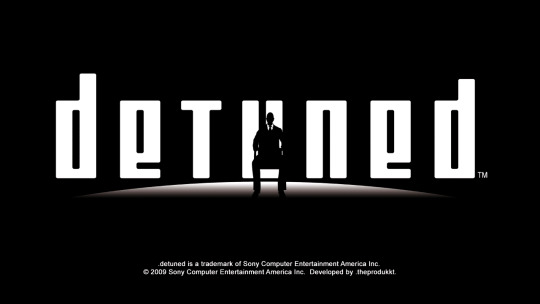
Released: Thursday, October 15, 2009 On: PlayStation Network for PlayStation 3 Developed by: .theprodukkt GmbH Published by: Sony Computer Entertainment America Inc.
Developed by .theprodukkt, .detuned™ is a personalized, interactive music experience which gives you the opportunity to create dynamic artwork in real-time to accompany your XMB™ music collection. Manipulate the given scene by interacting with and modifying its unique graphics using the DUALSHOCK®3 Wireless Controller. Plus you can change and tweak your own music to accompany the scene. .detuned™'s brilliant design and capabilities call for the state-of-the-art processing power that can only be done on the PS3™ system. Download .detuned™ today for an artistic music experience! Features: -Artistic Experiences: An abstract and surreal interactive experience to players of all levels and interests -Personalized Music: Manipulate and tweak music tracks on the XMB™ to accompany your artistic creations -Power of the PS3™ system: Stunning and crisp HD environment that brings your artistic visions to life in real-time
It started with a team of eleven people, a majority of which came from 49Games GmbH of Hamburg, Germany. 49Games GmbH’s main development was the annual winter and summer games for PC and consoles in Germany. Summer Athletics 2009 for Wii, released on July 24, 2009 was the largest collaborative effort, seeing nine of the eleven developers for .detuned credited on that game. An earlier collaborative effort is more closely related to the work of .detuned, a first person shooter game called .kkrieger. Released on April 10, 2004 for Windows PCs, .kkrieger was a product of the Breakpoint demoscene party in April 2004 in Bingen, Germany. It was the result of a challenge to create a first person shooter in the vein of Unreal Tournament and Quake but with the restriction of being 96KB in size. GameDeveloper has an interview with programmer Fabian Giesen (who was only 19 at the time!) and Nostalgia Nerd on YouTube has a great video documenting the development of .kkrieger that is worth a watch if you want to know more about how they accomplished this feat.
Sony Santa Monica Studios Producer Rusty Buchert announced .detuned on the PlayStation Blog on May 1, 2009. He said it would, “[offer] an abstract and surreal interactive experience like nothing else. It is not exactly a game or an art piece like Linger in Shadows. It allows you to create your own visual to accompany your favorite music tracks on the XMB, and using the SIXAXIS™ Wireless Controller, you will be able to manipulate the given scene by interacting with and modifying a man and his world. It even lets you tweak your music as you play with it.” Their announcement is already getting ahead of the “not a game!” crowd, though the comments on that PlayStation Blog piece are generally positive and welcoming.
.detuned would release on PSN for $2.99 on October 15, 2009. Games media reviews were limited, as most game “critics” were used to reviewing games such as Madden, Call of Duty, and Uncharted, but something like .detuned was challenging when approached from the limited scope of a consumer review with the stated goal being a buyer’s guide to “should you purchase this?” IGN gave it a 4/10, Bad, with Chris Roper saying, “Currently selling for $2.99 in the US PlayStation Store, that's about a dollar per minute of entertainment. If you have cash to blow and want to see one of the weirdest pieces of software on any system, go for it. Otherwise, just watch our videos and you'll get the point.” GamesRadar’s Shaun Curnow would rate .detuned 2.5/5 with its negatives being, “-Not really a game, -Won't amuse everyone, -Won't amuse for long.” Again we hit the same reactions and falsehoods of criticism, not being a [mainstream’s expectation of a] game, not reaching some imagined universal appeal, and not lasting long enough to be “worth” it in the mental formula of $/hour. A retrospective review in 2019 from Gaming Audio News’ Trevor Chan would say, “It didn’t take long to wonder if it was worth paying the small amount of money for this bite-sized experience. It’s a great snapshot of a bygone decade. Does that mean one would go recommending .detuned as a ‘must-play’? No, but it is worth experiencing, even if just for a few minutes.” Again we come back to reviews being centered on this one point: Monetary Price. No matter the time it costs you, don’t go questioning whether those 40 hours in the latest RPG were truly meaningful, be glad you got more bang for your buck compared to this!
As mentioned by GameSpy’s Sterlin McGarvey in their news writeup for .detuned’s announcement, Linger in Shadows, and .detuned, were positively regarded for their easy trophies, “It [Linger in Shadows] was also a handy way to clean up on some good trophies, another reason why many people picked it up.” This sentiment was echoed in PlayStation The Official Magazine Issue 22 for August 2009 whose Trophies for Cheaters by Carlos Ruiz includes entries for Linger in Shadows, Flower, and Noby Noby Boy. I admit, my purchase of Linger in Shadows and .detuned at the time was more for their easy trophies than interest in the demoscene or its history. It is only while looking back do I realize there is a richer field to examine than just a quick injection of trophy points.
What is .detuned if not a video game? The visual effects manually activated by the player suggests it is a visualizer meant to mesmerize you while enjoying your custom tracks imported onto the PlayStation 3 hard drive. Reliance on human, rather than machine, for these effects means the attention of the player is squarely on enacting movement to the rhythm of whatever track is currently being played instead of enjoying the track and visuals meshed together. Due to this, it reads as more of a toy, something to pick up and play around with, poking at its odds and ends, seeing what action you can provoke and manipulate, before setting it down and moving on. This briefness of experience and interest may be why publisher, reviewer, and player alike referred to it as, “not a game.” It failed, intentionally so, to entertain for multiple hours, tell a story, or offer a high score. Still, I find it limiting to restrict the moniker of “game” from .detuned and its ilk. The player can manipulate and control aspects programmed by the developer, engaging in a unique kind of conversation between player and program that can only happen in video games.
As a game, what does .detuned evoke? The first time through was spent poking and prodding at the game, seeing what the different button press combinations could accomplish and create in the suited man. The default track demo that you can watch to get an overall feel for what this game is capable of producing works well, though the cuts and camera movement seem way out of range of what the player is capable of producing when in control. The lack of an editable timeline means creating your own music video with this game as the base foundation would be a waste of time and effort. So, as before, it remains a toy, something you can plug a music track into in order to have some fun pulling and twisting it around in your hand, not quite as literal given the capability of the Sixaxis within the PlayStation 3 controller (though maybe for the best given the Sixaxis never achieved much in its lifetime). One of the tracks I chose to test out was probably the most apt for a repeatable batch of animations: Daft Punk’s “Around the World.” Some other experiments were on Blink 182’s “What’s My Age Again?” and M.O.O.N.’s “Hydrogen” from the Hotline Miami soundtrack. Unfortunately I did not realize I could turn off the sound effect to the “crank” noise when using the analog sticks to forward and rewind the animations. Due to this, my experience, and footage, are inseparable from the annoying click-clack of the crank.
In 2012 Q-Games released a game very similar to .detuned in intention, PixelJunk 4am, a game for the PlayStation Move motion controller that allowed players to, “Mix and create your own music with the PlayStation®Move. ‘Paint��� with sound in 3D space by pulling new tracks from the surrounding audio palette.” Though more social-minded than .detuned was, the audio effect manipulation and importing of your own custom tracks, aka your iTunes library, is very similar to the sandbox playground of .detuned, and is something I hope to try out once I obtain a PlayStation Move myself.
Some members of .theprodukkt continue to work in the demoscene today. Dierk Ohlerich (chaos) is an organizer for The Revision, a German demoparty that continues even to this year with an event in April 2023. Thomas Mahlke (fiver2) has continued working in the demoscene as well, most often with the group Farbrausch, one of the groups shouted out in Linger in Shadows. Tammo Hinrichs (kb) has also helped organize The Revision, and continues to make music for demos. Sebastian Grillmaier (wayfinder) has continued to create music for the scene and even provided the theme music for The Revision 2022. Christoph Mütze (giZMo) also appears to have remained active in the scene contributing to projects as late as 2021. Fabian Giesen (ryg) currently works at RAD Game Tools in Kirkland, Washington and maintains his blog to this day. Bleick Bleicken (mcfly) has most recently worked as an art director for Chorus developed by Deep Silver. I had trouble looking for any recent output from Oliver Waechter (joey) and Uwe Meier (moonlay). I believe Thomas Heinrich (aTom) is this same Thomas Heinrich on Twitter who links to Glare Productions as his current place of employment. Lastly Leonard Ritter (paniq) is currently a co-founder and developer at Duangle working on a crowdfunded game called Nowhere, an “alien life simulator.” The game has been in development since 2011 though sadly it appears the latest update was in March 2021.
Ever since my article on the short lived studio Endrant I’ve always wondered where these groups of people end up long after this project I’ve just played was probably last on their mind. Thankfully, in the comments of that Nostalgia Nerd video YouTube on .kkrieger there is a message from Tammo “kb” Hinrichs posted in October 2022 who gives an update on where the team is at now,
"Where are those guys now?" We exist, living our lives, all outside actual game development nowadays (because we wanted to have lives), but still quietly working away on various things that you might or might not have seen. Some of us are still active in the demoscene, and we're all fine, thank you :)
3 notes
·
View notes
Text
How an Data Analytics Certification Course Can Secure Your Job in the Evolving 2025 Market, Excel, VBA, SQL, MS Access, MS Power BI, Tableau. Alteryx, R Programming, "Business Analytics Certification Course in Delhi", 110008 -"Summer Offer 2025" Free Python Data Science Course" by SLA Consultants India,
A data analytics certification course is a powerful tool for securing your job in the rapidly evolving 2025 market, where digital transformation, AI integration, and cloud adoption are reshaping industries and job requirements. The demand for data analysts is at an all-time high, with the U.S. Bureau of Labor Statistics projecting a 23% increase in job opportunities by 2032, and this growth is expected to accelerate as more data becomes available across sectors like healthcare, finance, retail, and technology. Companies are actively seeking professionals who can turn raw data into actionable insights, making data analytics a critical function in business strategy and operations.
A comprehensive "Business Analyst Course in Delhi" (110008) with the "Summer Offer 2025" Free Python Data Science Course by SLA Consultants India—equips you with the most sought-after technical skills. Mastery of Excel and VBA enables efficient data cleaning, automation, and reporting, which are foundational for any data analyst role. SQL and MS Access are essential for data extraction and management, while advanced visualization tools like Power BI and Tableau are now standard for creating dynamic dashboards and communicating insights to stakeholders. Alteryx streamlines workflow automation and data blending, and R Programming is valued for advanced statistical analysis. The inclusion of a free Python Data Science Course further broadens your skill set, as Python is increasingly required for automation, machine learning, and big data processing—skills that are highly valued in today’s job market. Business Analyst Training Course in Delhi
Certification programs not only teach these technical competencies but also provide hands-on training, real-world projects, and industry exposure. This practical experience is crucial for demonstrating your abilities to potential employers and for building confidence in tackling complex business challenges. Employers are looking for candidates who can combine technical expertise with business acumen and strong communication skills, and a certification signals your commitment to professional development and mastery of current tools. Moreover, certifications from reputable providers are recognized by top companies and can significantly boost your resume, making you stand out in a competitive job market where even entry-level salaries are rising—now averaging $90,000 in the US. Business Analyst Training Institute in Delhi
Business Analyst Programme Modules
Module 1 - Basic and Advanced Excel With Dashboard and Excel Analytics
Module 2 - VBA / Macros - Automation Reporting, User Form and Dashboard
Module 3 - SQL and MS Access - Data Manipulation, Queries, Scripts and Server Connection - MIS and Data Analytics
Module 4 - Tableau | MS Power BI ▷ BI & Data Visualization
Module 5 - Python | R Programing ▷ BI & Data Visualization
Module 6 - Python Data Science and Machine Learning - 100% Free in Offer - by IIT/NIT Alumni Trainer
In summary, a data analytics certification course is a strategic investment for job security and career advancement in 2025. By mastering tools like Excel, VBA, SQL, Power BI, Tableau, Alteryx, R, and Python—and leveraging structured, industry-recognized training—you position yourself as a highly valuable asset to employers across industries. The Business Analyst Certification Course in Delhi with a free Python Data Science Course offers a comprehensive pathway to acquiring these in-demand skills, ensuring you are well-prepared to thrive in the evolving, high-growth field of data analytics. For more details Call: +91-8700575874 or Email: [email protected]
0 notes
Text

Top Features of Workflow Tools
Drag-and-Drop Workflow Builder
Create custom workflows easily with a visual interface — no coding required.
Task Automation
Automate repetitive tasks such as email alerts, approvals, and status updates.
Custom Forms and Fields
Design forms to capture specific data relevant to your workflow steps.
Role-Based Access Control
Define user permissions based on roles to ensure data security and clarity in task ownership.
Real-Time Notifications & Alerts
Get updates via email or in-app notifications on task changes, delays, or completions.
Integration with Other Tools
Connect with CRM, ERP, accounting software, or communication tools like Slack, MS Teams, etc.
Analytics & Reporting
Track workflow performance, bottlenecks, and productivity with dashboards and exportable reports.
Conditional Logic
Use IF/THEN rules to build intelligent workflows that adapt based on input or status.
Mobile Access
Use workflows on-the-go via mobile apps for approvals, task updates, or submissions.
Audit Trail & History Tracking
Maintain logs of who did what and when — crucial for compliance and accountability.
0 notes
Text
One of the key features of the recently released operating system from Microsoft is its Windows Store. Users of Windows 8 can download apps from the store instead of searching for them online. For now, there are just 5,000 apps available on the store, but Microsoft is planning to increase the number of apps available for its customers. Windows 8 has brought significant improvement to its mobile device operating system. There are drastic changes focused on improving user experience. Windows Store apps run within the Windows Runtime. Some simple apps can be easily created on this platform using HTML5 and JavaScript. Below are some of the best free apps available on Windows Store for Windows 8 OS: FlipToast Flip Toast is an app which brings together many social networking services like Facebook, Twitter, LinkedIn and Instagram. The updates from these social networking services are displayed in a very graphic-rich and magazine-like format. The content displayed on the app can be swiped from left to right using your finger if your computer features a touch screen. Using this app, you can post updates on social networks, write comments, like others' posts, etc. The only limitation of this app is that Google + and FLickr are not yet supported which will be a disappointment for some users. Fresh Paint Fresh Paint is a painting app with many new features when compared with the old MS Paint. You can create new drawings, edit them with ease and color them with picturebook-like pages. There are lot of brushes and colours to choose from. If you get bored with the available options in the app, you can buy more (extra outlines and brushes) for a nominal price. This app can work wonders if your device is touch enabled. Evernote Evernote is the world's favorite mobile note taking app. You can record notes using Evernote app on Windows 8 by scribbling, typing, recording, and sketching. The notes which are taken on Evernote are displayed in the form of tiles which looks very cool. IM+ IM+ is an app for handling multiple messaging services on Windows 8. This app is already very famous on mobile platforms like iOS and Android. IM+ supports multiple messaging/chatting services like Google Chat, Facebook, Yahoo!, and even Microsoft's own Windows Live Messenger. You can send and receive files like photographs and Notes when communicating through this app. It also support for group chats making it a good choice for chat addicts. News Bento Apps for all the major news websites are available for Windows 8. But, Installing all these can make your home screen crowded. You can overcome this problem by installing this single handy app and follow news on multiple news websites. This app presents news in a format that is easy to read and which does not put much strain on the eyes. Important news stories are presented along with big pictures and excerpts. A key feature of this app is that it also has support for Google Reader making it easy to read atom and RSS feeds. Kindle Reading books on the earlier versions of Windows was not a good experience. Now the Kindle app for Windows 8 promises to make reading on the Windows PC a good experience. This app provides complete access to Amazon's online book store. You can also sync all your Kindle collection from your other devices easily by connecting your Windows 8 PC with them. Other options include the ability to change font sizes, screen brightness, page format, etc. Wikipedia Lot of people still access Wikipedia through their browsers. The Wikipedia app for Windows 8 comes with a simple left to right reading arrangement. This is totally different from the up and down scrolling arrangement in a browser. The left to right reading arrangement gives the feel of reading a book to the users. The app has links to Wikipedia's 'featured articles', top events which happened on 'this day', and links to recently accessed pages. You can also access articles posted in multiple languages on the same topic through this app.
Once this app is installed on your PC, you can search Wikipedia's huge database through your regular Windows 8 search tool. It would have been better if all the Wikipedia articles accessible through this app are properly indexed. StumbleUpon StumbleUpon, the top app in the world to find new content on the internet is now available on Windows 8. You need to just open a free StumbleUpon account and specify your interests. The app will show lot of content related to your interests like photographs, webpages, articles, and, blogs. You can also vote whether you like what is displayed on the app or not . The display of this app is gorgeous with lot of viewing real estate and allows you to swipe from one side of the screen to the other side endlessly. This is one of the few apps available on Windows Store which seem to be tailor made for Windows 8. XE Currency XE Currency app for Windows 8 allows you to convert all currencies in the world. It has a currency converter with live rates which are updated every minute through the internet. The app also stores last update it downloads so that it can be used even when internet is not available. You can always monitor the exchange rates of up to ten currencies on the display section of the app. Apart from currency rates, this app also displays the prices of precious metals like Gold and Platinum. TuneIn Radio Internet radio is a good way of keeping yourself entertained with music. TuneIn Radio app for Windows 8 has a huge database of 70,000 internet radio stations from across the world. The radio stations can be browsed by music, sport, news, chat, demography, language, etc. You can also enable the app to access your location through GPS so that it can just find and connect to the local station when you are on the move. There is an option to create lists of your favorite stations which can be accessed by you later. You can enhance your Windows 8 PC with above top free apps which are now available in Windows Store. All these apps can be easily downloaded and installed on your PC with just a click or two. This is a Guest Post by Alia. She is a writer/blogger. She loves writing, traveling and blogging. Some of her recent work can be found at Rick Daniels.
0 notes
Text
TEACHER’S EMPOWERMENT PROGRAMME
Location: Little Angels, Sonepat
Resource Person: Ms. Leena Rai Kalra, Leader, UN Volunteers – India
Date: 26/05/2025
Theme: Integrating Technology in Teaching – Domain II (CBSE In-house Training)
The Teacher’s Empowerment Programme held at Little Angels, Sonepat, on 26th May 2025, proved to be a significant stride toward modernizing classroom practices. Led by Ms. Leena Rai Kalra, a dynamic leader from UN Volunteers – India, the session focused on equipping educators with the knowledge and skills to effectively integrate technology into their teaching methodologies.
The session opened with an insightful discussion on the transition from traditional tools such as pen, paper, and chalkboards to the digital era marked by tablets, notepads, and smartboards. Ms. Kalra emphasized the increasing necessity of this shift, attributing it to the evolving needs of learners and the demand for greater accessibility, engagement, and flexibility in education. She highlighted how technology facilitates self-paced learning, wider access to resources, and efficient planning and assessment for teachers.
Participants engaged in hands-on activities with popular educational tools including Kahoot, Padlet, Canva, and Google Forms. Through these interactive platforms, teachers explored ways to create engaging quizzes, digital posters, real-time polls, and feedback forms. The activities not only demystified the use of technology but also encouraged teachers to showcase their creativity and innovation in designing teaching aids.
The training concluded on an enthusiastic note, with teachers expressing increased confidence and readiness to incorporate these tools into their classrooms. The session successfully bridged the gap between traditional and digital teaching methods, fostering a collaborative and forward-thinking learning environment.
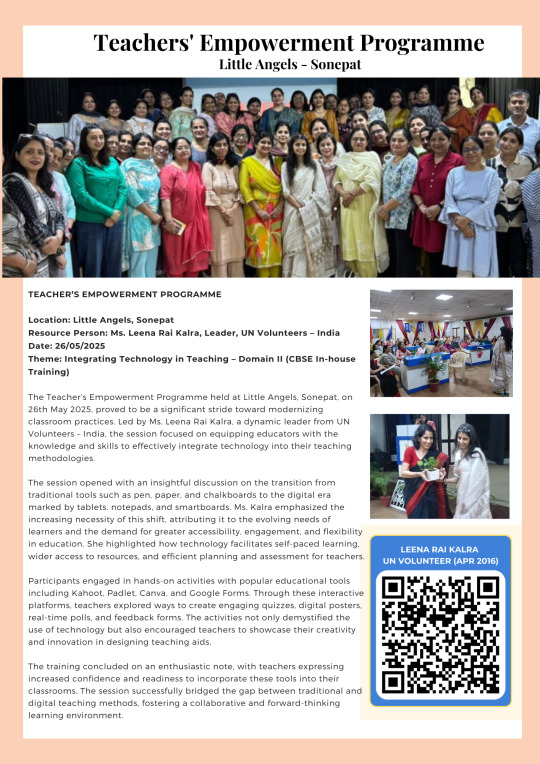
0 notes